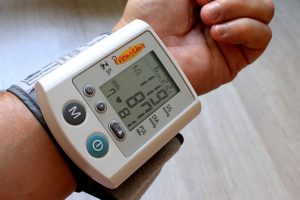Why You Should Regularly Use a Wrist Blood Pressure Monitor
Using a Wrist Blood Pressure Monitor
 Typical wrist blood pressure monitor • Image by Adriano Gadini from Pixabay
Are the routine days I take
A measure of my blood pressure
And heart rate.
Sometimes the numbers are on the high
And sometimes on the low,
But mostly they are in between
The numerical range the doctors deem
As normal, better circulation flow.
I am glad to say that over
Many months I have found,
Perusing measurements recorded,
My average blood pressure going down
And a healthier state of being sound!
–– ©2023 Carl Scott Harker, author of
The Hedgehog and other Selected Poems. |
|
Wrist blood pressure monitors are portable devices designed to measure blood pressure at the wrist. They are a convenient alternative to traditional arm cuff monitors and are often used by individuals at home who find it more comfortable or have difficulty using arm cuff monitors. Here are some key points about wrist blood pressure monitors:
How They Work:
Wrist blood pressure monitors operate on the same basic principles as traditional arm cuff monitors. They use an inflatable cuff to temporarily cut off blood flow in the artery, and then release the pressure to measure the force of blood against the artery walls.
Placement:
To use a wrist blood pressure monitor, the device is typically worn on the inside of the wrist, just above the wrist bone. The user should keep the wrist at heart level during the measurement for accurate results.
Convenience:
Wrist blood pressure monitors are compact and portable, making them convenient for travel or home use. They are easy to use without assistance and are generally less cumbersome than traditional monitors.
Accuracy:
While wrist monitors can be accurate, they may be more prone to user error. It’s crucial to follow the manufacturer’s instructions carefully to ensure proper positioning and technique. Some individuals may get less accurate readings with wrist monitors due to differences in anatomy and the potential for arm movement during measurement.
Considerations for Accuracy:
Factors such as wrist size, position during measurement, and body movement can affect the accuracy of readings. It’s important to maintain proper posture and follow the guidelines provided with the specific device.
Conditions for Use:
Some individuals may not be suitable candidates for wrist blood pressure monitoring. For example, those with certain medical conditions, like arrhythmias or diabetes, may get more accurate readings with traditional arm cuff monitors.
Consulting healthcare professionals:
While wrist blood pressure monitors can be useful for monitoring trends and tracking changes in blood pressure, it’s crucial to consult with healthcare professionals for a comprehensive assessment of your blood pressure and overall cardiovascular health.
Validation:
Some healthcare professionals may prefer upper arm monitors for their accuracy and consistency. If you’re using a wrist blood pressure monitor, it’s advisable to have your device validated against readings taken by healthcare professionals or with a validated upper arm monitor. I normally take a reading before a scheduled doctor’s visit, knowing I will again have my blood pressure taken. That gives me a chance to compare numbers.
Battery or power source:
Wrist blood pressure monitors typically use batteries for power. It’s essential to check and replace batteries as needed to ensure accurate readings.
Price Range:
Wrist blood pressure monitors are available in a range of prices, with basic models being more affordable and advanced models with additional features (such as memory storage, smartphone connectivity, etc.) being more expensive.
Recording the results:
Remember to record each time you take a measure of your blood pressure. It is a good way to see if changes in lifestyle or medication is effecting or improving your blood pressure condition.
It’s essential to note that accurate blood pressure measurement is crucial for managing and monitoring health conditions. Regular check-ups with healthcare professionals are recommended, and any home monitoring should be done in consultation with a healthcare provider.
News About Blood Pressure
|